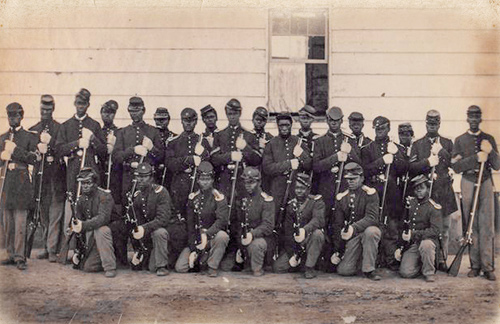Reading between the lines
Imagine researching a group of soldiers. Lots of historic letters exist about these soldiers, much of it disparaging. What’s a historian to do? Kelan Amme ’24, a history major with a public history concentration, went to the source—the soldiers themselves.
Last summer, he spent several weeks on the University of Southern Mississippi campus sifting through letters—
many of them disparaging—about the United States Colored Troops (USCT) during the Civil War.  One of 10 students in the country selected for the Mapping Freedom NSF-REU (National Science Foundation - Research Experience for Undergrads), Amme was part of the first cohort of the project. The group used a database of letters sent to and from Mississippi governors during the Civil War and Reconstruction eras, combining them with geographical information systems (GIS) to visualize the data as maps. That’s when Amme became interested specifically in the cultural attitudes about the USCT.
One of 10 students in the country selected for the Mapping Freedom NSF-REU (National Science Foundation - Research Experience for Undergrads), Amme was part of the first cohort of the project. The group used a database of letters sent to and from Mississippi governors during the Civil War and Reconstruction eras, combining them with geographical information systems (GIS) to visualize the data as maps. That’s when Amme became interested specifically in the cultural attitudes about the USCT.
“Traditionally, historians, especially public historians now, look at the past through a different lens, where, instead of focusing on one narrative, we try to find as many points of view and how we can reflect on and reconstruct that narrative to better include different groups and different opinions,” explained Amme. “By using different sources and different opinions, we can match the accounts of the United States Colored Troops’ letters and the accounts written in the Mississippians’ letters and how the accounts of that impact the Civil War at large and what it means for opportunities for African Americans at this time.”
The culmination of Amme’s project includes an interactive map with points that, when clicked, take the reader to primary sources, such as letters and newspapers, providing an accessible snapshot of the attitudes of local Mississippians toward the presence of the USCT. The letters provide a deeper understanding into how people in states such as Mississippi reacted to the Union Army—and the USCT.
“I was able to get a better understanding of how the United States Colored Troops worked within the Union Army and what it was like for the USCT to travel during the war. After all the [white] Southerners had fled, having only enslaved individuals in the town and seeing them run outside in celebration as the African American soldiers march in their blue uniforms, providing a sense of hope and freedom for the future,” said Amme.
Looking at the primary sources this way, says Amme, people today can listen to and elevate voices from the past often silenced or left out of historical narratives. One account involved a soldier who came into a town and was recognized by a longtime resident who said, “Your mother is here.”
When he was two or three, he was taken from [his mother] into enslavement, and he was actually able to reconnect with his mother as an adult, which was such a fascinating story,” he said.
Through the letters, Amme also explored the hierarchy of the soldiers who served then.
“We’re seeing opportunities for white officers and African American soldiers to connect outside of what has traditionally been thought of those relationships at the time. There’s a lot of really interesting voices that have never been published in this way before. Using mapping technology and seeing where they were geographically and what it was like for an African American soldier to write a letter saying, ‘We are now in a trench going to storm a fort tomorrow morning,’ and seeing what those experiences were like. I was really excited to be able to see that, as it provides a better sense of agency for the voices that are left out,” said Amme.
After Amme graduates, he will attend Rutgers University to pursue a Master of Information, concentrating in archives and preservation to ultimately work as an archivist. He says that Messiah’s education and programs have set him up well for success in what he wants to do. The field of digital humanities opens up new opportunities for museums and archives to communicate history in more effective ways, such as the mapping project.
“My goal for the future, combined with this skill set, is to ask, ‘How can we use information in new ways? How can we use information in ways that are accessible?’” he said. “How can we break boundaries socially, culturally and historically?”
— Samantha Neal ’23
Sidebar:
Who were the USCT?
 “The United States Colored Troops first became widely introduced into the Union in 1862 after the Emancipation Proclamation, with enlistment and conscription efforts popping up nationwide, even in the Southern states. One instance that caught my eye occurred in New Orleans with the formation of the Louisiana Native Guards. Gen. Order No. 63, issued by General Benjamin Butler in August 1862, created this opportunity. These soldiers, made up of African American militia veterans, became some of the first regiments allocated into the Union Army. As time passed, these soldiers were sent to guard Ship Island, Mississippi, a barrier island previously occupied by the Confederacy during the beginning of the war. While on the island, the soldiers guarded the fortifications and conducted raids on the Mississippi coastline, earning praise from their superiors for the effort shown in battle.”
“The United States Colored Troops first became widely introduced into the Union in 1862 after the Emancipation Proclamation, with enlistment and conscription efforts popping up nationwide, even in the Southern states. One instance that caught my eye occurred in New Orleans with the formation of the Louisiana Native Guards. Gen. Order No. 63, issued by General Benjamin Butler in August 1862, created this opportunity. These soldiers, made up of African American militia veterans, became some of the first regiments allocated into the Union Army. As time passed, these soldiers were sent to guard Ship Island, Mississippi, a barrier island previously occupied by the Confederacy during the beginning of the war. While on the island, the soldiers guarded the fortifications and conducted raids on the Mississippi coastline, earning praise from their superiors for the effort shown in battle.”
—Excerpted from the Kelan Amme’s paper, “Visualizing the Myth and Folklore of the USCT”
Sidebar:
A lens to the past
Kelan Amme ’24 credits two professors in particular for guiding his Messiah journey
Sarah Myers, associate professor of history
“She has been influential in supporting my various ventures into public history and guiding my academic and professional career throughout my time at Messiah University. Dr. Myers has always been available to assist with the various projects I’ve worked on, including helping me outline the interview questions for my documentary with the Dauphin County Library System and providing me with the opportunity to apply for the Mapping Freedom REU at the University of Southern Mississippi,” said Amme.
David Pettegrew, professor of history and archaeology
“Without Dr. Pettegrew, I would not have been able to be involved with any of the community-based projects centered around the historic African American community in Harrisburg, Pennsylvania. I am appreciative of Dr. Pettegrew’s continued commitment to creating and supporting new avenues for learning and academic exploration that have ultimately allowed me to pursue unique historical topics centered around racial reconciliation and social justice,” said Amme.
At Messiah, Amme found professors who helped him to look the past. As he pursues a career as an archivist, his Messiah education and his professors have already helped him map out his future.